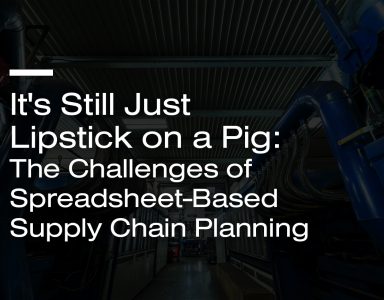
Every January, millions of people start the New Year with a list of resolutions. From weight loss to career to finances, the list of things to change and improve are diverse and aimed at pushing someone to the next level. People make these resolutions to set goals and milestones for themselves for the future based on realizations from the past.
But resolutions can be valuable for companies too. Especially those who want to use the new year as a launchpad for improvement. As customer expectations grow more sophisticated and as technology advances, companies are feeling the pressure to bring more products to market faster and with higher degrees of customization while maintaining or improving service levels.
These growing expectations affect all areas of a product company. They will become the “new norm” for design, production, shipping, finance, and other functional areas who will settle in and incorporate the new reality into their daily operating procedures. But for those on the front lines tasked with supply chain planning this changing environment will require the ability not only to initiate the materials, sources, and logistics for new products at the outset. For planners, these trends will never just “settle in”. Supply chain planners will also need to manage them in a state of constant change moving forward. For many mid-sized organizations, this taxes planning staff with an increase in disparate spreadsheets, follow-up, logistics, and inventory management that can result in overworked staff, higher cost, missed opportunities, or worse.
For companies looking to up their game in supply chain planning in the new year, new software and new platforms may be required to get them going. And when considering what deliverables new software should bring to the table, a list of New Year’s Resolutions is a great place to start. Here are a few resolutions that can deliver the capability for supply chain planners to enable them to take on increased expectations (and fuel increased growth) in the coming year:
Become More Agile:
The ability to act and react nimbly, and with ease, to changing supply chain issues has traditionally been a function of human skillsets at the planning level. Some companies performed better—or worse—at this task depending on staffing. But with consumer tastes shifting quickly and the demand for shorter lead times becoming a stronger consideration for purchases, companies need to deploy stronger analytical tools to stay nimble and make fast decisions using data-driven insight. A strong planning platform can help a company meet their resolution for agility by enhancing their visualization of the entire supply chain so that all elements of the chain are operating under a single version of the truth. Many of these platforms allow strong “what-if” analysis and can be linked to MRP or ERP systems to fully integrate the plan and allow decisions to be made quickly and more effectively.
Become More Flexible:
Product companies that rely heavily upon human capital to anticipate change and react accordingly often fall short. With unexpected changes that cause supply chain disruption throughout the system, planners often feel as though they are attempting to “surf behind the wave”. The problem isn’t dedication or drive, but a lack of automated tools to bring together people, processes, and data quickly and seamlessly. Meeting a resolution to be more flexible should include consideration of platforms that allow staff to move from a reactive to a proactive stance with the right data in the right format to easily modify their plans based on new circumstances.
Right-Size the Planning Solution:
One of the most common resolutions for individuals is the promise to manage finances more carefully in the new year. And for most companies, this resolution is a sound premise as well. Faced with an increasingly complex supply chain many companies may overreach and overengineer their purchase of software as a solution to a problem. But a strong resolution to find affordable solutions doesn’t mean overspending. Today’s platforms are modular and can offer companies what they need for their specific requirements without over-engineering the system. This allows companies to find and deploy affordable “right-sized” solutions that are expandable over time and as the company grows.
Be More Efficient:
All resolutions have one thing in common, to make things better in a short period of time. And while there have been many buzzwords over the last two decades such as Lean, Six Sigma, and other similar initiatives, at the end of the day all product companies want to be more efficient. With customer demands becoming more time conscious, supply chain planners are faced with finding new ways to complete traditional spreadsheet-based tasks more quickly and efficiently to allow them the time to make critical business decisions without getting bogged down.
Maximize your Resources:
To keep supply and demand in balance, cloud-based modular software applications, such as DemandCaster, can automate many of the repetitive tasks and replace a spreadsheet-driven planning system with an intuitive, data-driven model that reduces or eliminates tasks, keystrokes, and tedious manual analysis. The entire supply chain can be viewed locally or globally and can translate demand plans into smaller time buckets to secure supply over time. They also allow the planning and determination of future inventory requirements based on real-world constraints. With these formerly manual tasks harnessed under a single version of the truth, decision making at the enterprise level is enhanced and the use of materials, equipment, and staff are maximized.
Become a Value-Added Contributor:
Traditional thinking has usually classified supply chain planning as “overhead”, a necessary evil required to allow production or product sourcing to drive the “true” value to a product company. But today’s software solutions for supply chain planning offer companies a unique resolution for the coming year by allowing them to move from a perception of overhead to one of a value-added contributor within the organization. These platforms are cloud-based, meaning that a company need not invest in hardware to achieve full value. Additionally, changes to the functionality are available instantly without the need of costly upgrades and retraining. It also eliminates “Version Fatigue” as they never age out due to missed or skipped upgrades. All these features reduce overall operating costs both in terms of up-front cost as well as maintenance cost over time.
An added plus is that today’s software also allows supply chain planning to lead innovation as well. As new features and functionality become available, supply chain planning can quickly incorporate new functionality within the system to the benefit of other functional areas. As the supply chain management system becomes more capable and efficient, design, production, product sourcing, inventory, and finance can improve their standard operating procedures to take advantage of the new capabilities within the supply chain system. As a result, instead of “overhead”, supply chain planning and management becomes a source of innovation and improvement and becomes a value-added component of the company.
As customer demands continue to escalate and acceptable lead times continue to shrink, the challenge falls first to the supply chain planners within a product company. If they answer those challenges in ways that drive innovation and improve efficiency and profits, their competitive advantage will increase. And for those companies whose New Year’s Resolutions include finding solutions to those challenges, the right planning software can be the right way to start the new year.
Contact us if you would like to learn how DemandCaster can help you end the chaos and reap the benefits of an agile, supply chain planning process.


